check engine YAMAHA YZF-R1 2014 Owners Manual
[x] Cancel search | Manufacturer: YAMAHA, Model Year: 2014, Model line: YZF-R1, Model: YAMAHA YZF-R1 2014Pages: 114, PDF Size: 2.87 MB
Page 6 of 114

TABLE OF CONTENTSSAFETY INFORMATION.................. 1-1
DESCRIPTION .................................. 2-1
Left view ......................................... 2-1
Right view ....................................... 2-2
Controls and instruments ............... 2-3
INSTRUMENT AND CONTROL
FUNCTIONS ...................................... 3-1
Immobilizer system......................... 3-1
Main switch/steering lock............... 3-2
Indicator lights and warning lights............................................ 3-4
Multi-function meter unit ................ 3-8
D-mode (drive mode).................... 3-18
Handlebar switches ...................... 3-18
Clutch lever .................................. 3-20
Shift pedal .................................... 3-21
Brake lever.................................... 3-21
Brake pedal .................................. 3-22
Traction control system ................ 3-22
Fuel tank cap ................................ 3-24
Fuel ............................................... 3-25
Fuel tank breather hose and
overflow hose ............................ 3-26
Catalytic converter ....................... 3-27
Seats ............................................ 3-27
Helmet holder ............................... 3-29
Storage compartment .................. 3-29
Rider footrest position .................. 3-30
Rear view mirrors.......................... 3-30 Adjusting the front fork ................. 3-31
Adjusting the shock absorber
assembly.................................... 3-33
Luggage strap holders .................. 3-35
Sidestand ...................................... 3-35
Ignition circuit cut-off system ....... 3-36
FOR YOUR SAFETY –
PRE-OPERATION CHECKS ............. 4-1
OPERATION AND IMPORTANT
RIDING POINTS ................................ 5-1
Starting the engine .......................... 5-1
Shifting ............................................ 5-2
Tips for reducing fuel consumption ................................ 5-3
Engine break-in ............................... 5-3
Parking ............................................ 5-4
PERIODIC MAINTENANCE AND
ADJUSTMENT ................................... 6-1
Owner’s tool kit ............................... 6-2
Periodic maintenance chart for the emission control system .............. 6-3
General maintenance and lubrication chart ........................... 6-4
Removing and installing cowlings... 6-8
Checking the spark plugs ............. 6-10
Engine oil and oil filter cartridge.... 6-11
Coolant.......................................... 6-14
Air filter element ............................ 6-17 Checking the engine idling
speed ........................................ 6-17
Checking the throttle grip free play ............................................ 6-18
Valve clearance............................. 6-18
Tires .............................................. 6-18
Cast wheels .................................. 6-21
Adjusting the clutch lever free
play ............................................ 6-21
Checking the brake lever free play ............................................ 6-22
Brake light switches ..................... 6-23
Checking the front and rear brake pads .......................................... 6-23
Checking the brake fluid level ...... 6-24
Changing the brake fluid .............. 6-25
Drive chain slack........................... 6-25
Cleaning and lubricating the drive chain.......................................... 6-27
Checking and lubricating the
cables ........................................ 6-27
Checking and lubricating the throttle grip and cable ............... 6-28
Checking and lubricating the brake and shift pedals............... 6-28
Checking and lubricating the
brake and clutch levers ............. 6-29
Checking and lubricating the sidestand................................... 6-29
Lubricating the swingarm pivots......................................... 6-30U2SGE0E0.book Page 1 Wednesday, June 12, 2013 1:15 PM
Page 10 of 114

SAFETY INFORMATION
1-3
1Avoi
d Car bon Monoxi de Poisonin g
All engine exhaust contains carbon
monoxide, a deadly gas. Breathing
carbon monoxide can cause head-
aches, dizziness, drowsiness, nausea,
confusion, and eventually death.
Carbon Monoxide is a colorless, odor-
less, tasteless gas which may be pres-
ent even if you do not see or smell any
engine exhaust. Deadly levels of car-
bon monoxide can collect rapidly and
you can quickly be overcome and un-
able to save yourself. Also, deadly lev-
els of carbon monoxide can linger for
hours or days in enclosed or poorly
ventilated areas. If you experience any
symptoms of carbon monoxide poi-
soning, leave the area immediately, get
fresh air, and SEEK MEDICAL TREAT-
MENT. Do not run engine indoors. Even if
you try to ventilate engine exhaust
with fans or open windows and
doors, carbon monoxide can rap-
idly reach dangerous levels.
Do not run engine in poorly venti-
lated or partially enclosed areas
such as barns, garages, or car-
ports.
Do not run engine outdoors where
engine exhaust can be drawn into
a building through openings such
as windows and doors.
Loa din g
Adding accessories or cargo to your
motorcycle can adversely affect stabil-
ity and handling if the weight distribu-
tion of the motorcycle is changed. To
avoid the possibility of an accident, use
extreme caution when adding cargo or
accessories to your motorcycle. Use
extra care when riding a motorcycle
that has added cargo or accessories.
Here, along with the information about
accessories below, are some general
guidelines to follow if loading cargo to
your motorcycle:
The total weight of the operator, pas-
senger, accessories and cargo must
not exceed the maximum load limit.
Operation of an overloa ded vehicle
coul d cause an acci dent. When loading within this weight limit,
keep the following in mind:
Cargo and accessory weight
should be kept as low and close to
the motorcycle as possible. Se-
curely pack your heaviest items as
close to the center of the vehicle
as possible and make sure to dis-
tribute the weight as evenly as
possible on both sides of the mo-
torcycle to minimize imbalance or
instability.
Shifting weights can create a sud-
den imbalance. Make sure that
accessories and cargo are se-
curely attached to the motorcycle
before riding. Check accessory
mounts and cargo restraints fre-
quently.
• Properly adjust the suspension for your load (suspension-ad-
justable models only), and
check the condition and pres-
sure of your tires.
• Never attach any large or heavy items to the handlebar, front
fork, or front fender. These
items, including such cargo as
sleeping bags, duffel bags, or
Maximum loa d:
189 kg (417 lb)
U2SGE0E0.book Page 3 Wednesday, June 12, 2013 1:15 PM
Page 12 of 114

SAFETY INFORMATION
1-5
1operator and may limit control
ability, therefore, such accesso-
ries are not recommended.
Use caution when adding electri-
cal accessories. If electrical ac-
cessories exceed the capacity of
the motorcycle’s electrical sys-
tem, an electric failure could re-
sult, which could cause a
dangerous loss of lights or engine
power.
Aftermarket Tires an d Rims
The tires and rims that came with your
motorcycle were designed to match
the performance capabilities and to
provide the best combination of han-
dling, braking, and comfort. Other
tires, rims, sizes, and combinations
may not be appropriate. Refer to page
6-18 for tire specifications and more in-
formation on replacing your tires.
Transportin g the Motorcycle
Be sure to observe following instruc-
tions before transporting the motorcy-
cle in another vehicle. Remove all loose items from the
motorcycle.
Check that the fuel cock (if
equipped) is in the “OFF” position
and that there are no fuel leaks.
Point the front wheel straight
ahead on the trailer or in the truck
bed, and choke it in a rail to pre-
vent movement.
Shift the transmission in gear (for
models with a manual transmis-
sion).
Secure the motorcycle with tie-
downs or suitable straps that are
attached to solid parts of the mo-
torcycle, such as the frame or up-
per front fork triple clamp (and not,
for example, to rubber-mounted
handlebars or turn signals, or
parts that could break). Choose
the location for the straps carefully
so the straps will not rub against
painted surfaces during transport.
The suspension should be com-
pressed somewhat by the tie-
downs, if possible, so that the mo-
torcycle will not bounce exces-
sively during transport.
U2SGE0E0.book Page 5 Wednesday, June 12, 2013 1:15 PM
Page 14 of 114
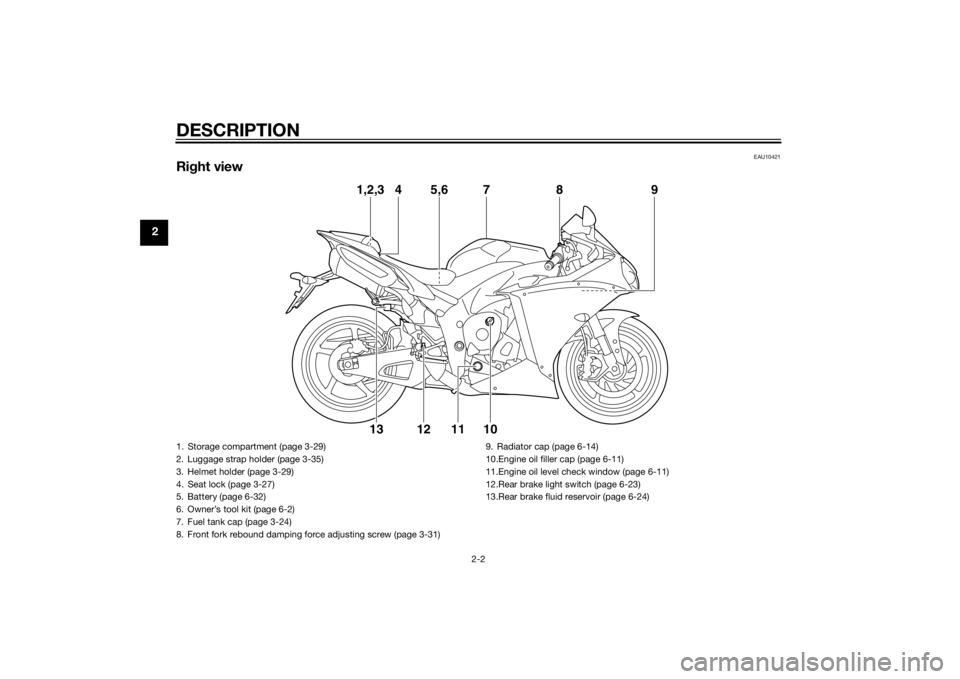
DESCRIPTION
2-2
2
EAU10421
Right view
1,2,3
4
9
5,6
7
8
10
11
12
13
1. Storage compartment (page 3-29)
2. Luggage strap holder (page 3-35)
3. Helmet holder (page 3-29)
4. Seat lock (page 3-27)
5. Battery (page 6-32)
6. Owner’s tool kit (page 6-2)
7. Fuel tank cap (page 3-24)
8. Front fork rebound damping force adjusting screw (page 3-31) 9. Radiator cap (page 6-14)
10.Engine oil filler cap (page 6-11)
11.Engine oil level check window (page 6-11)
12.Rear brake light switch (page 6-23)
13.Rear brake fluid reservoir (page 6-24)U2SGE0E0.book Page 2 Wednesday, June 12, 2013 1:15 PM
Page 19 of 114
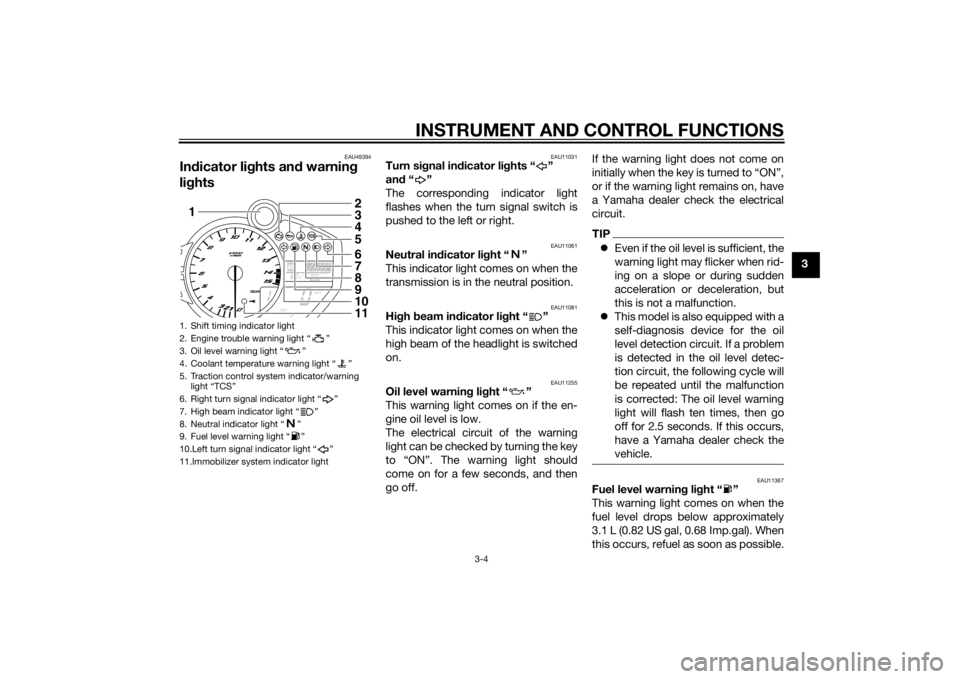
INSTRUMENT AND CONTROL FUNCTIONS
3-4
3
EAU49394
Indicator lig hts and warning
lig hts
EAU11031
Turn si gnal in dicator li ghts “ ”
an d“”
The corresponding indicator light
flashes when the turn signal switch is
pushed to the left or right.
EAU11061
Neutral in dicator li ght “ ”
This indicator light comes on when the
transmission is in the neutral position.
EAU11081
Hi gh beam in dicator li ght “ ”
This indicator light comes on when the
high beam of the headlight is switched
on.
EAU11255
Oil level warnin g lig ht “ ”
This warning light comes on if the en-
gine oil level is low.
The electrical circuit of the warning
light can be checked by turning the key
to “ON”. The warning light should
come on for a few seconds, and then
go off. If the warning light does not come on
initially when the key is turned to “ON”,
or if the warning light remains on, have
a Yamaha dealer check the electrical
circuit.
TIP
Even if the oil level is sufficient, the
warning light may flicker when rid-
ing on a slope or during sudden
acceleration or deceleration, but
this is not a malfunction.
This model is also equipped with a
self-diagnosis device for the oil
level detection circuit. If a problem
is detected in the oil level detec-
tion circuit, the following cycle will
be repeated until the malfunction
is corrected: The oil level warning
light will flash ten times, then go
off for 2.5 seconds. If this occurs,
have a Yamaha dealer check the
vehicle.
EAU11367
Fuel level warnin g li ght “ ”
This warning light comes on when the
fuel level drops below approximately
3.1 L (0.82 US gal, 0.68 Imp.gal). When
this occurs, refuel as soon as possible.
1. Shift timing indicator light
2. Engine trouble warning light “ ”
3. Oil level warning light “ ”
4. Coolant temperature warning light “ ”
5. Traction control system indicator/warning light “TCS”
6. Right turn signal indicator light “ ”
7. High beam indicator light “ ”
8. Neutral indicator light “ ”
9. Fuel level warning light “ ”
10.Left turn signal indicator light “ ”
11.Immobilizer system indicator light1 2
34561178910
U2SGE0E0.book Page 4 Wednesday, June 12, 2013 1:15 PM
Page 20 of 114
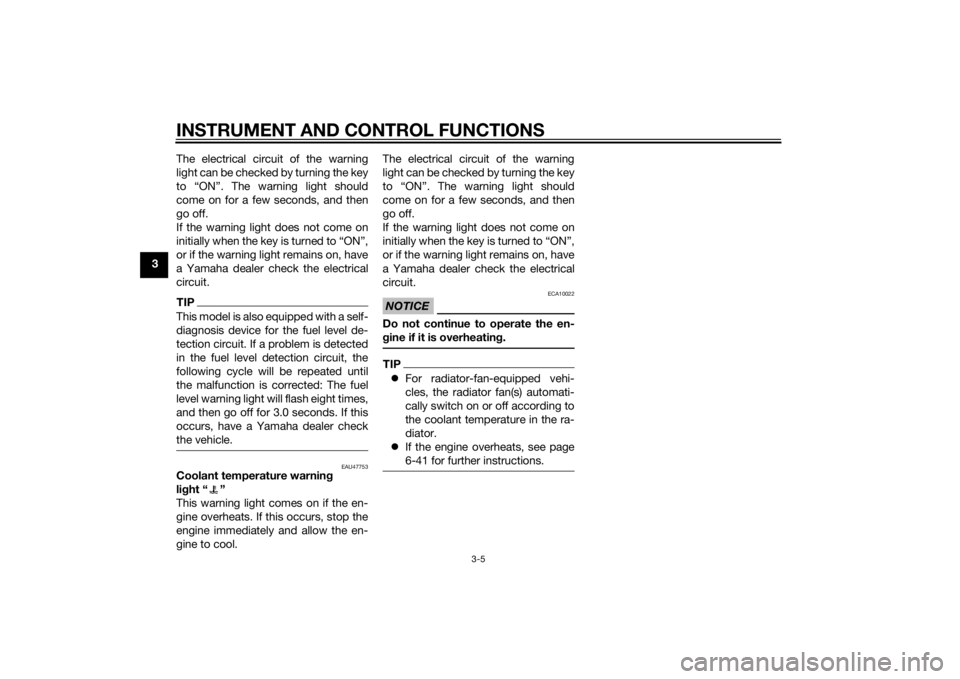
INSTRUMENT AND CONTROL FUNCTIONS
3-5
3The electrical circuit of the warning
light can be checked by turning the key
to “ON”. The warning light should
come on for a few seconds, and then
go off.
If the warning light does not come on
initially when the key is turned to “ON”,
or if the warning light remains on, have
a Yamaha dealer check the electrical
circuit.
TIPThis model is also equipped with a self-
diagnosis device for the fuel level de-
tection circuit. If a problem is detected
in the fuel level detection circuit, the
following cycle will be repeated until
the malfunction is corrected: The fuel
level warning light will flash eight times,
and then go off for 3.0 seconds. If this
occurs, have a Yamaha dealer check
the vehicle.
EAU47753
Coolant temperature warnin
g
li g ht “ ”
This warning light comes on if the en-
gine overheats. If this occurs, stop the
engine immediately and allow the en-
gine to cool. The electrical circuit of the warning
light can be checked by turning the key
to “ON”. The warning light should
come on for a few seconds, and then
go off.
If the warning light does not come on
initially when the key is turned to “ON”,
or if the warning light remains on, have
a Yamaha dealer check the electrical
circuit.
NOTICE
ECA10022
Do not continue to operate the en-
g
ine if it is overheatin g.TIP For radiator-fan-equipped vehi-
cles, the radiator fan(s) automati-
cally switch on or off according to
the coolant temperature in the ra-
diator.
If the engine overheats, see page
6-41 for further instructions.
U2SGE0E0.book Page 5 Wednesday, June 12, 2013 1:15 PM
Page 22 of 114
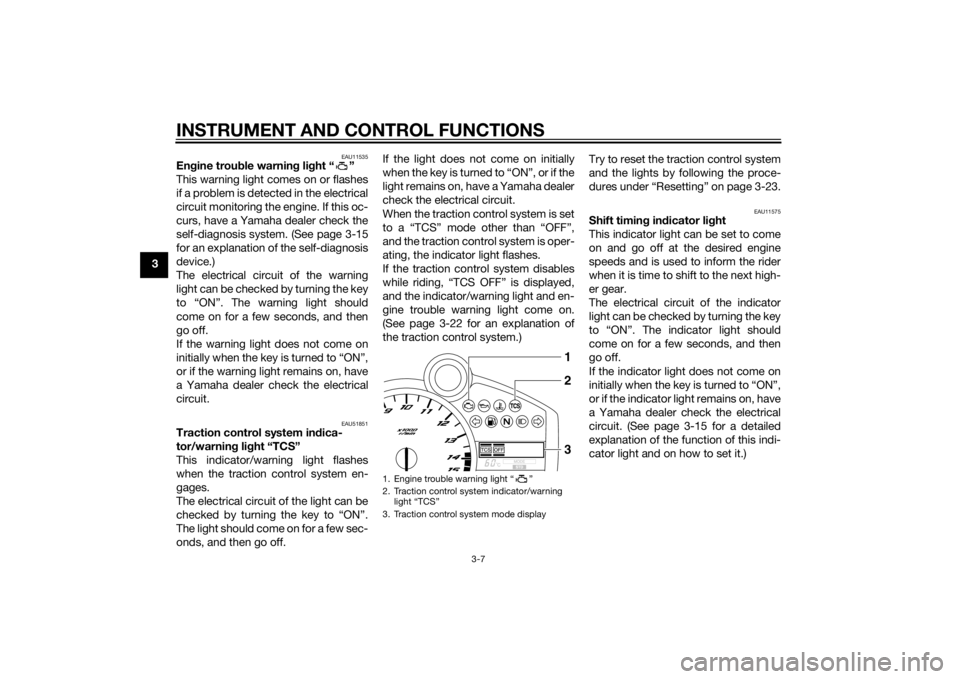
INSTRUMENT AND CONTROL FUNCTIONS
3-7
3
EAU11535
Engine trou ble warnin g lig ht “ ”
This warning light comes on or flashes
if a problem is detected in the electrical
circuit monitoring the engine. If this oc-
curs, have a Yamaha dealer check the
self-diagnosis system. (See page 3-15
for an explanation of the self-diagnosis
device.)
The electrical circuit of the warning
light can be checked by turning the key
to “ON”. The warning light should
come on for a few seconds, and then
go off.
If the warning light does not come on
initially when the key is turned to “ON”,
or if the warning light remains on, have
a Yamaha dealer check the electrical
circuit.
EAU51851
Traction control system in dica-
tor/warnin g li ght “TCS”
This indicator/warning light flashes
when the traction control system en-
gages.
The electrical circuit of the light can be
checked by turning the key to “ON”.
The light should come on for a few sec-
onds, and then go off. If the light does not come on initially
when the key is turned to “ON”, or if the
light remains on, have a Yamaha dealer
check the electrical circuit.
When the traction control system is set
to a “TCS” mode other than “OFF”,
and the traction control system is oper-
ating, the indicator light flashes.
If the traction control system disables
while riding, “TCS OFF” is displayed,
and the indicator/warning light and en-
gine trouble warning light come on.
(See page 3-22 for an explanation of
the traction control system.)
Try to reset the traction control system
and the lights by following the proce-
dures under “Resetting” on page 3-23.
EAU11575
Shift timin
g in dicator li ght
This indicator light can be set to come
on and go off at the desired engine
speeds and is used to inform the rider
when it is time to shift to the next high-
er gear.
The electrical circuit of the indicator
light can be checked by turning the key
to “ON”. The indicator light should
come on for a few seconds, and then
go off.
If the indicator light does not come on
initially when the key is turned to “ON”,
or if the indicator light remains on, have
a Yamaha dealer check the electrical
circuit. (See page 3-15 for a detailed
explanation of the function of this indi-
cator light and on how to set it.)
1. Engine trouble warning light “ ”
2. Traction control system indicator/warning light “TCS”
3. Traction control system mode display
123
U2SGE0E0.book Page 7 Wednesday, June 12, 2013 1:15 PM
Page 30 of 114
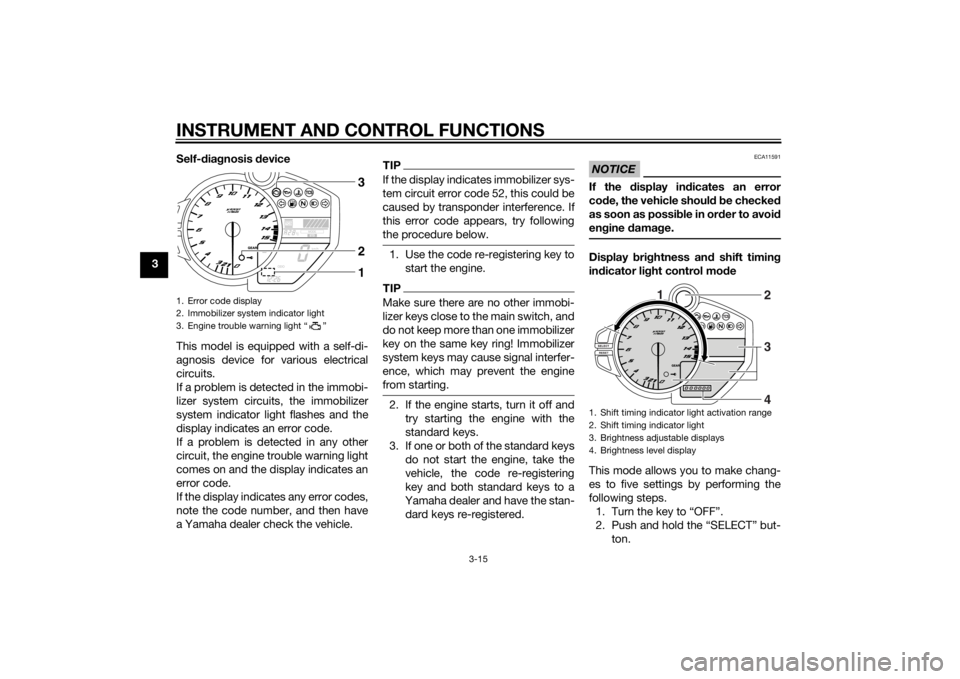
INSTRUMENT AND CONTROL FUNCTIONS
3-15
3Self-d
iagnosis device
This model is equipped with a self-di-
agnosis device for various electrical
circuits.
If a problem is detected in the immobi-
lizer system circuits, the immobilizer
system indicator light flashes and the
display indicates an error code.
If a problem is detected in any other
circuit, the engine trouble warning light
comes on and the display indicates an
error code.
If the display indicates any error codes,
note the code number, and then have
a Yamaha dealer check the vehicle.
TIPIf the display indicates immobilizer sys-
tem circuit error code 52, this could be
caused by transponder interference. If
this error code appears, try following
the procedure below.1. Use the code re-registering key to start the engine.TIPMake sure there are no other immobi-
lizer keys close to the main switch, and
do not keep more than one immobilizer
key on the same key ring! Immobilizer
system keys may cause signal interfer-
ence, which may prevent the engine
from starting.2. If the engine starts, turn it off andtry starting the engine with the
standard keys.
3. If one or both of the standard keys do not start the engine, take the
vehicle, the code re-registering
key and both standard keys to a
Yamaha dealer and have the stan-
dard keys re-registered.
NOTICE
ECA11591
If the display in dicates an error
co de, the vehicle shoul d b e checked
as soon as possi ble in or der to avoi d
en gine damag e.Display bri ghtness an d shift timin g
in dicator li ght control mo de
This mode allows you to make chang-
es to five settings by performing the
following steps. 1. Turn the key to “OFF”.
2. Push and hold the “SELECT” but- ton.
1. Error code display
2. Immobilizer system indicator light
3. Engine trouble warning light “ ”
132
1. Shift timing indicator light activation range
2. Shift timing indicator light
3. Brightness adjustable displays
4. Brightness level display
1
2
3
4
U2SGE0E0.book Page 15 Wednesday, June 12, 2013 1:15 PM
Page 39 of 114
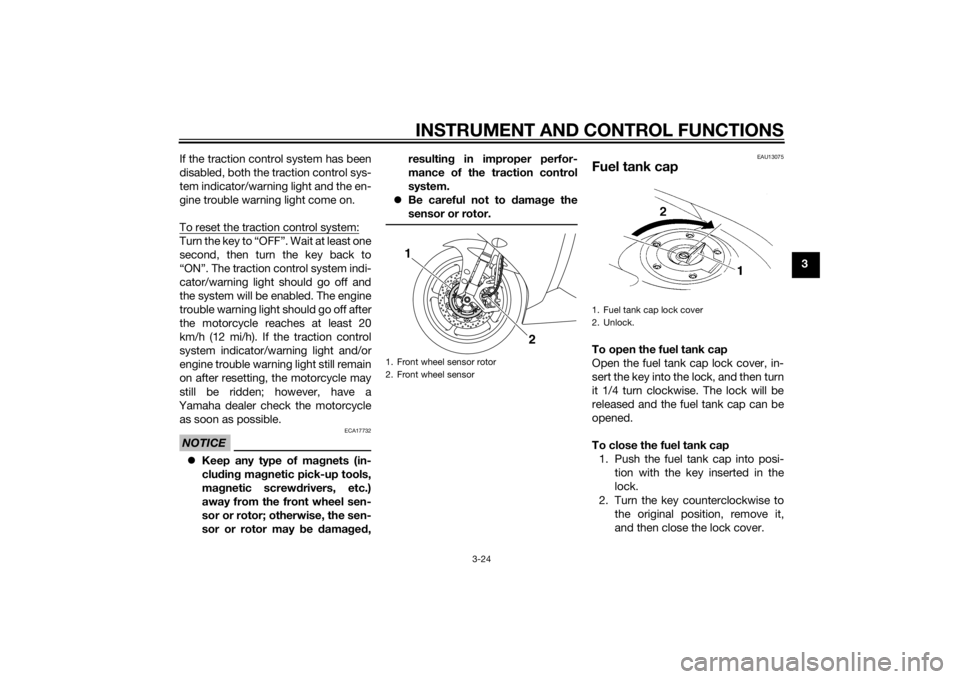
INSTRUMENT AND CONTROL FUNCTIONS
3-24
3
If the traction control system has been
disabled, both the traction control sys-
tem indicator/warning light and the en-
gine trouble warning light come on.
To reset the traction control system:
Turn the key to “OFF”. Wait at least one
second, then turn the key back to
“ON”. The traction control system indi-
cator/warning light should go off and
the system will be enabled. The engine
trouble warning light should go off after
the motorcycle reaches at least 20
km/h (12 mi/h). If the traction control
system indicator/warning light and/or
engine trouble warning light still remain
on after resetting, the motorcycle may
still be ridden; however, have a
Yamaha dealer check the motorcycle as soon as possible.NOTICE
ECA17732
Keep any type of mag nets (in-
clu din g ma gnetic pick-up tools,
ma gnetic screw drivers, etc.)
away from the front wheel sen-
sor or rotor; otherwise, the sen-
sor or rotor may be damag ed , resultin
g in improper perfor-
mance of the traction control
system.
Be careful not to d amage the
sensor or rotor.
EAU13075
Fuel tank capTo open the fuel tank cap
Open the fuel tank cap lock cover, in-
sert the key into the lock, and then turn
it 1/4 turn clockwise. The lock will be
released and the fuel tank cap can be
opened.
To close the fuel tank cap 1. Push the fuel tank cap into posi- tion with the key inserted in the
lock.
2. Turn the key counterclockwise to the original position, remove it,
and then close the lock cover.
1. Front wheel sensor rotor
2. Front wheel sensor
2
1
1. Fuel tank cap lock cover
2. Unlock.
U2SGE0E0.book Page 24 Wednesday, June 12, 2013 1:15 PM
Page 41 of 114
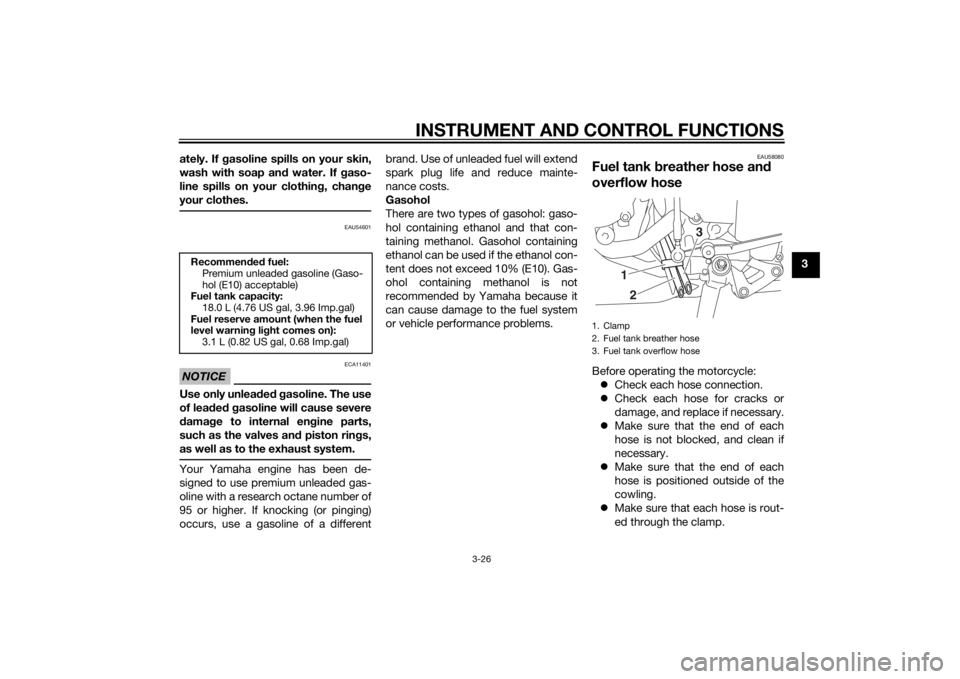
INSTRUMENT AND CONTROL FUNCTIONS
3-26
3
ately. If g
asoline spills on your skin,
wash with soap an d water. If gaso-
line spills on your clothin g, chan ge
your clothes.
EAU54601
NOTICE
ECA11401
Use only unlea ded g asoline. The use
of lead ed g asoline will cause severe
d amag e to internal en gine parts,
such as the valves an d piston rin gs,
as well as to the exhaust system.Your Yamaha engine has been de-
signed to use premium unleaded gas-
oline with a research octane number of
95 or higher. If knocking (or pinging)
occurs, use a gasoline of a different brand. Use of unleaded fuel will extend
spark plug life and reduce mainte-
nance costs.
Gasohol
There are two types of gasohol: gaso-
hol containing ethanol and that con-
taining methanol. Gasohol containing
ethanol can be used if the ethanol con-
tent does not exceed 10% (E10). Gas-
ohol containing methanol is not
recommended by Yamaha because it
can cause damage to the fuel system
or vehicle performance problems.
EAU58080
Fuel tank
breather hose an d
overflow hoseBefore operating the motorcycle:
Check each hose connection.
Check each hose for cracks or
damage, and replace if necessary.
Make sure that the end of each
hose is not blocked, and clean if
necessary.
Make sure that the end of each
hose is positioned outside of the
cowling.
Make sure that each hose is rout-
ed through the clamp.
Recommen ded fuel:
Premium unleaded gasoline (Gaso-
hol (E10) acceptable)
Fuel tank capacity:
18.0 L (4.76 US gal, 3.96 Imp.gal)
Fuel reserve amount (when the fuel
level warnin g li ght comes on):
3.1 L (0.82 US gal, 0.68 Imp.gal)
1. Clamp
2. Fuel tank breather hose
3. Fuel tank overflow hose
21 3
U2SGE0E0.book Page 26 Wednesday, June 12, 2013 1:15 PM